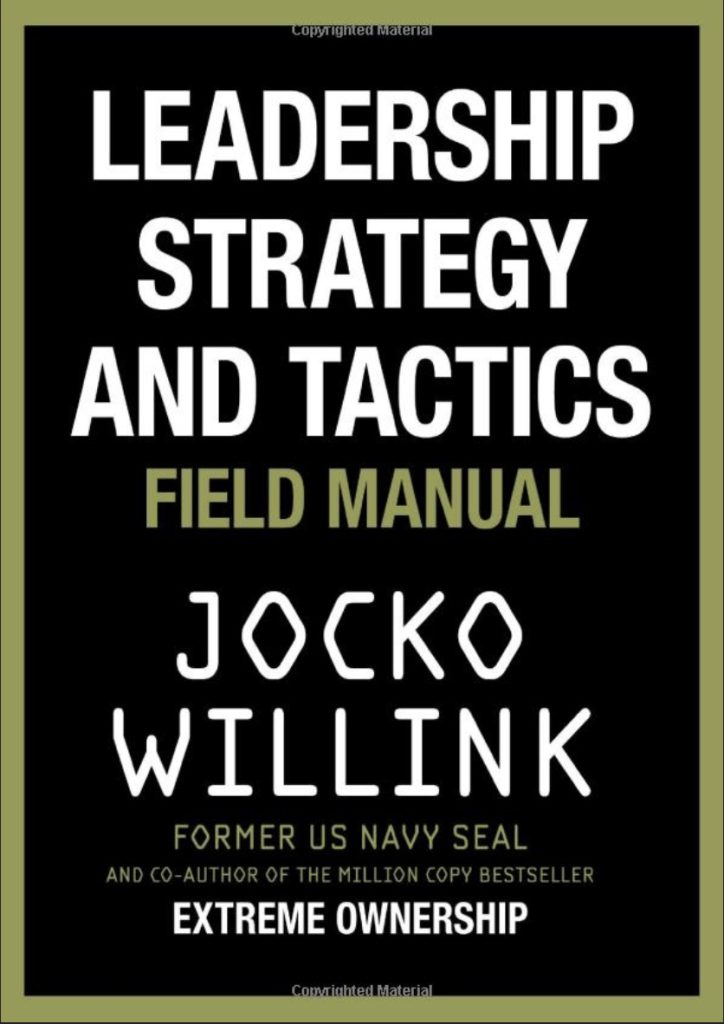“Change is the reality of life; almost everything is in a constant state of flux. And it is a crucial part of a leader’s job to figure out which changes are important and which are mere distractions” (p. 127).
Key Points and Concepts
Foundations
“By detaching physically, even if only by a few inches, and, more important, detaching mentally from the problem at hand — I was able to see infinitely more” (p. 17). People often put their heads down and focus inward when they confront a challenge. Do not do this, instead, take a minute to create some distance between you and the problem and look at it again. When you detach yourself, you have a much better perspective to work from.
“He said he was looking forward to working with us all.” Willink says as a leader, you may have different responsibilities than those below you; however, you are all part of the same team. Team members are working with you to achieve a goal, not to achieve it for you (p. 26).
“Put the onus on yourself as to why [an] idea doesn’t make sense” (p. 48). People who feel attacked shut down, and it becomes very difficult to be productive. If you or a team member is not communicating effectively, do not attack them for it, put your ego aside, and explain that you are not clear on what they are saying.
Core Tenets
As a person and a leader, “take ownership, take extreme ownership, don’t make excuses, don’t blame any person, or any other thing, get control of your ego, and don’t hide your delicate pride,” do not look for excuses to shift responsibility. As a leader, it all starts with you (p. 46).
“Ask to learn and actually do. Sight in that sniper weapon. Program that radio … get familiar and then actually practice the task.” Leaders are responsible for knowing what techniques and tools their teams use during a project. While it can be helpful to get an overview, there is no substitute for hands-on experience. Ask those below you to teach you the tools they use and make sure you know how to use them in real life. Showing competency in real-world situations is key to earning the respect needed to lead (p. 87).
“Treat people with respect. What does that mean? Allow them to give their opinion. Listen to them. Don’t interrupt them. Don’t disparage the importance of their job or position. Share the burden of hard tasks” (p. 97).
“Regardless of the reason the gunner failed, it is the leader’s fault. A leader is responsible for everything a person on his or her team does.” You must be involved with your team members. That does not mean you need to directly talk to each individual on a personal level, but failure to effectively teach or communicate always stems from the top. Invest in understanding (p 102).
“A team or some of the individuals on the team can be ruined if the leader’s approach is inappropriate or is applied with the wrong amount of pressure.” Just because something has worked in one team does not mean it will work on another. Back off, reassess, and try something different instead of trying the same strategy, but harder (p. 120).
“Change is the reality of life; almost everything is in a constant state of flux. And it is a crucial part of a leader’s job to figure out which changes are important and which are mere distractions” (p. 127). Do not get bogged down in the small details. As a leader, it is your responsibility to keep a global view of the problems you are solving, and filter out the noise.
“A leader in a combat scenario can only keep track of and direct four to six people, maximum. The noise, confusion, fog of war, distance, and the limitations of communications caused by all those factors prevent even the best leaders from trying to lead groups any larger than four to six people.” Do not overextend your direct sphere of influence. Keep it small enough so that you can have clear and direct lines of communication with all of your people (p. 132).
Becoming a Leader
“Come up with a plan. Give a simple, clear, concise direction. Stay humble, take input, and listen, and of course, lead.” Organizations of any size have a person who holds the majority stake in what a group does. That does not mean that they should not include other people in the decision-making process. Do not let ego get in the way; be open to other courses of action that people propose (p. 171).
“Leadership, in most cases, should be subtle … It is better to give subtle direction and let the troops move forward based on their own ideas. The same thing goes for mentoring and coaching.” Do not over-impose your will on your team. A subtle course correction to make sure that people head in the right direction is far more effective than constant pressure to achieve a goal in a specific way (p. 178).
Leadership Skills
“Don’t dig in unless you have no choice — and, even then, always try to leave yourself some room to maneuver.” When confronted with pushback from your team, do not shut down, and continue moving forward as though the solution you have picked is the only one. Stop, reassess, and always leave other options available (p. 190).
“When I’ve been unsure about a situation or did not have good enough information to make a bold, clear decision, I utilized an iterative decision-making process. That means I looked at the situation and made small decisions to move toward a direction that aligned with my best guess on what the situation was, without overcommitting since I wasn’t sure” (p. 192).
“Don’t alienate yourself from the group, become part of it and earn your influence.” To be successful when you join a new team as a leader, you must adapt your standard operating procedure to that of the group. The faster you become a cohesive unit, the faster you can become productive (p. 204).
Maneuvers
There are always team members who have bad attitudes or who do not pull their weight. The standard practice is to use negative reinforcement to get them to change their attitude. This strategy does not work very often; instead, try to give them responsibilities that force them to change their attitude or work ethic to succeed. “You needed to put him in charge of something that matters. Something that is important and that will challenge him” (p. 213).
“It is okay to quit on a tactical objective; maybe you don’t take that hill or clear that sector of the city right now … but you don’t quit the strategic mission. If you have made the strategic assessment and decision that this tyrannical leader must be removed for the safety and security of your nation, then you have to drive on; you cannot quit your strategic aims” (p. 253). Discarding a plan because it is not working is not a failure; the most important thing is achieving your goal, and if that means trying something new, so be it.
Communication
“The hardest part of this from a leader’s perspective is understanding that the team doesn’t always see what you see.” It is a leader’s job to maintain a level of detachment so that they can see the larger picture. In contrast, team members focus on smaller-scale issues. When communicating with your team, it is imperative to contextualize information and recognize that something that seems obvious to you may not be to the team because of the difference in perspectives (p. 260).
“There is a dichotomy; praise should be given when warranted. But it must be given judiciously, and it should be tempered with a goal” (p. 279).
“There is nothing wrong with apologizing when you make a mistake. That is part of taking ownership” (p. 294). You do not give up power or influence by recognizing a misstep; in fact, people will respect you more for your humility and honesty.
Willink, J. (2020). Leadership Strategy and Tactics: Field Manual. New York: St. Martin’s Pres

“Change is the reality of life; almost everything is in a constant state of flux. And it is a crucial part of a leader’s job to figure out which changes are important and which are mere distractions” (p. 127).
“As a person and a leader, “take ownership, take extreme ownership, don’t make excuses, don’t blame any person, or any other thing, get control of your ego, and don’t hide your delicate pride,” do not look for excuses to shift responsibility. As a leader, it all starts with you.”
“Don’t dig in unless you have no choice — and, even then, always try to leave yourself some room to maneuver.” When confronted with pushback from your team, do not shut down, and continue moving forward as though the solution you have picked is the only one. Stop, reassess, and always leave other options available.”
“There is a dichotomy; praise should be given when warranted. But it must be given judiciously, and it should be tempered with a goal.”
